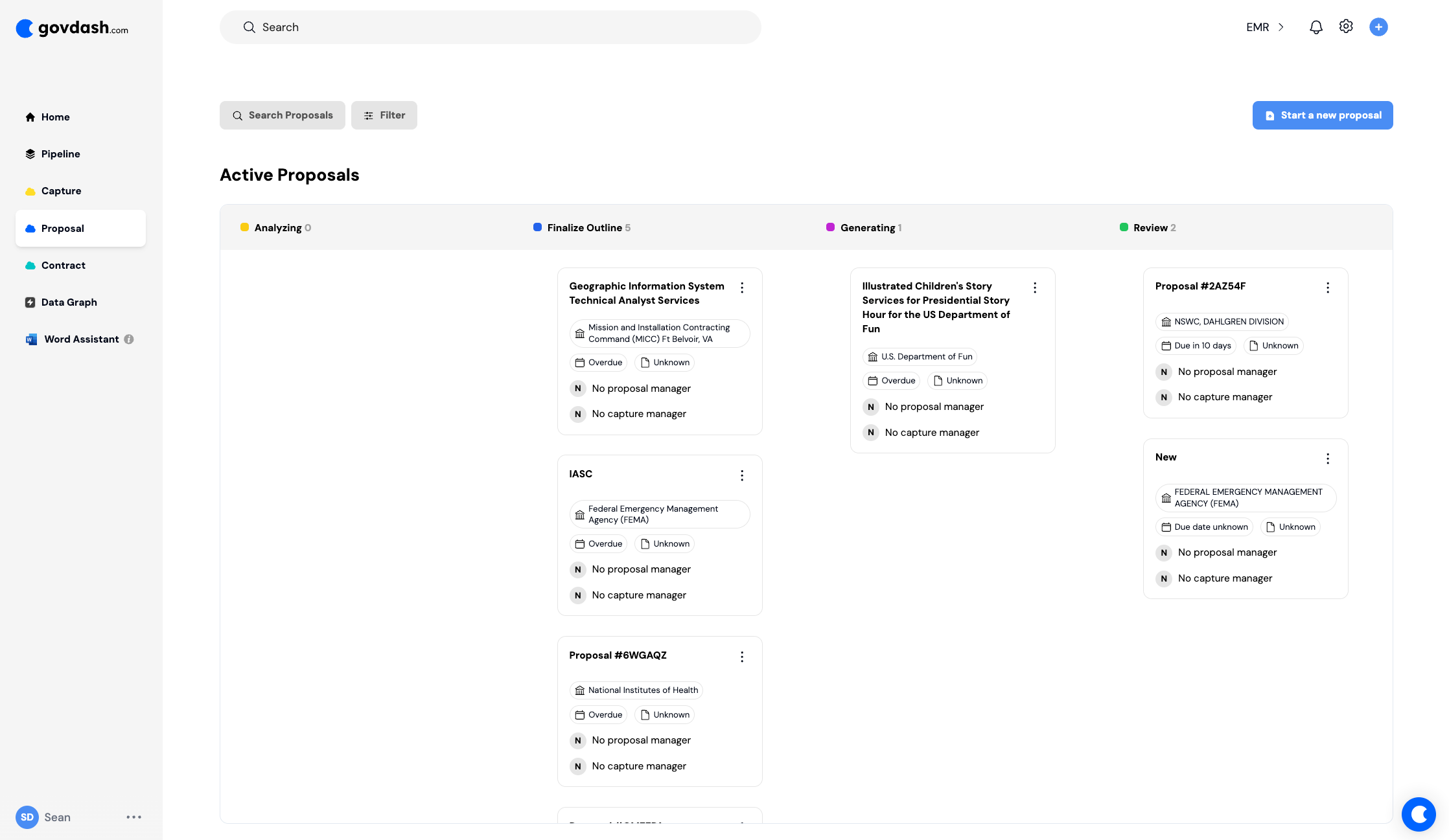GovDash is a software as a service (SaaS) platform that leverages artificial intelligence to streamline the entire business development lifecycle for government contracting companies. GovDash provides everything needed to help teams win more contracts from identifying opportunities, guiding through the capture process, building compliance matrices, annotating outlines, writing proposals before delivering the final product into a Microsoft Word document. Contractors can go from discovering an opportunity to running compliance and producing a high-quality proposal in a matter of days.
According to Sean Doherty, CEO and co-founder of GovDash, government contracting firms typically rely on a “capture team” to identify opportunities then develop potential solutions. Traditionally, it takes weeks to consolidate information and even longer for proposals teams to then create a proposal. With the GovDash platform, proposal managers can utilize its built-in AI assistant to get the necessary data into the platform, which then incorporates the data as it generates the proposal. Additionally, GovDash’s Word Assistant can create graphics to support the narrative, potentially saving thousands of dollars compared to hiring third party designers.
Enhancing compliant documents and proposals with Azure OpenAI
GovDash is built on the Azure OpenAI Service, leveraging its advanced capabilities to optimize operations. At the inception of their Optical Character Recognition (OCR) pipeline, GovDash employed Azure Document Intelligence to extract ground-truth text from PDF documents. This then undergoes a series of automated prompts to clean and transform it into a usable format.
Spanning multiple US regions, the GovDash platform utilizes Azure’s OpenAI service and includes a custom load balancer to manage rate limits and distribute workload effectively. This infrastructure has resulted in a significant reduction in error rates and latency compared to the OpenAI first-party API.

GovDash’s system integrates numerous chained prompts to generate detailed outlines and compliance matrices, which are subsequently fed into an advanced Retrieval-Augmented Generation (RAG) content generation flow. This process manages millions of input and output tokens per proposal processing hundreds of millions of tokens daily. This architecture empowers GovDash to deliver highly detailed and compliant proposals, enhancing service delivery to government contractors.
Avoid trendy solutions by building for long-term use cases
Compared to other companies creating similar solutions, Doherty believes the positive reception to their product comes down to their ability to go deep into the government contracting workflow by leveraging models and data.
“Other companies that have tried to do this, they’re more like prompting engines where they’ll say to their customers: ‘Hey, go out and find these instructions here, copy and then paste them in’ and then the product will write something for you,” Doherty explains. “GovDash is more like an employee. It takes the solicitation and does the heavy lifting up front then checks in with your team at all critical points. We’ve done some work to be able to get this to work.”
As with any good idea out there, it took time to plan and create the GovDash. Founded alongside Timothy Goltser and Curtis Mason, both of whom are board members of GovDash, Doherty and company began their founder journey by presenting ideas to friends and family who work in the government contracting industry.
“A number of our family friends are federal contractors, primarily in the IT services space and, basically, we went to them pitching ideas and they and they almost shook us and said: ‘No, listen, the number one problem that we have is our ability to get compliant and compelling proposals out the door with limited resources,’” Doherty tells Microsoft for Startups. “Not only because there’s a lot that goes into that process, so it’s very tedious, but because it directly limits the amount of revenue that they can bring in.”
As eager as people are to capitalize on the AI craze, Doherty advises founders to focus on building products in areas where the workflows are so complicated that models alone cannot do them. This approach is particularly crucial for aspiring entrepreneurs who aim for long-term success rather than short-term gains.
“It’s like the Internet gold rush; everyone’s trying to get in and throw something at the wall,” Doherty says. “We had a very strict set of criteria for what we did here. And because we didn’t want to go down the path of building something and having it blown up as models got better.”
Doherty elaborates further, saying: “I’ve seen a lot of friends from Y-Combinator as well, where they built something that is solving a problem in the short term. But if you extrapolate out with models becoming a more performant, is that still a use case?”
Microsoft for Startups Founders Hub members receive Azure cloud credits that can be used towards a variety of Azure services, including Azure OpenAI Service, as well as expert advisory from the team at Microsoft to build and deploy their solutions. Founders Hub is open to all startups and takes just minutes to apply – sign up today.






